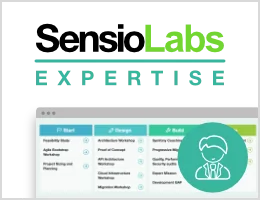Url
Validates that a value is a valid URL string.
| Applies to | property or method |
| Class | Url |
| Validator | UrlValidator |
Basic Usage
1 2 3 4 5 6 7 8 9 10
// src/Entity/Author.php
namespace App\Entity;
use Symfony\Component\Validator\Constraints as Assert;
class Author
{
#[Assert\Url]
protected string $bioUrl;
}1 2 3 4 5
# config/validator/validation.yaml
App\Entity\Author:
properties:
bioUrl:
- Url: ~1 2 3 4 5 6 7 8 9 10 11 12
<!-- config/validator/validation.xml -->
<?xml version="1.0" encoding="UTF-8" ?>
<constraint-mapping xmlns="http://symfony.com/schema/dic/constraint-mapping"
xmlns:xsi="http://www.w3.org/2001/XMLSchema-instance"
xsi:schemaLocation="http://symfony.com/schema/dic/constraint-mapping https://symfony.com/schema/dic/constraint-mapping/constraint-mapping-1.0.xsd">
<class name="App\Entity\Author">
<property name="bioUrl">
<constraint name="Url"/>
</property>
</class>
</constraint-mapping>1 2 3 4 5 6 7 8 9 10 11 12 13 14 15
// src/Entity/Author.php
namespace App\Entity;
use Symfony\Component\Validator\Constraints as Assert;
use Symfony\Component\Validator\Mapping\ClassMetadata;
class Author
{
// ...
public static function loadValidatorMetadata(ClassMetadata $metadata): void
{
$metadata->addPropertyConstraint('bioUrl', new Assert\Url());
}
}This constraint doesn't check that the host of the given URL really exists, because the information of the DNS records is not reliable. Use the checkdnsrr PHP function if you still want to check that.
Note
As with most of the other constraints, null and empty strings are
considered valid values. This is to allow them to be optional values.
If the value is mandatory, a common solution is to combine this constraint
with NotBlank.
Options
groups
type: array | string default: null
It defines the validation group or groups of this constraint. Read more about validation groups.
message
type: string default: This value is not a valid URL.
This message is shown if the URL is invalid.
You can use the following parameters in this message:
| Parameter | Description |
|---|---|
{{ value }} |
The current (invalid) value |
{{ label }} |
Corresponding form field label |
1 2 3 4 5 6 7 8 9 10 11 12
// src/Entity/Author.php
namespace App\Entity;
use Symfony\Component\Validator\Constraints as Assert;
class Author
{
#[Assert\Url(
message: 'The url {{ value }} is not a valid url',
)]
protected string $bioUrl;
}1 2 3 4 5 6
# config/validator/validation.yaml
App\Entity\Author:
properties:
bioUrl:
- Url:
message: The url "{{ value }}" is not a valid url.1 2 3 4 5 6 7 8 9 10 11 12 13 14
<!-- config/validator/validation.xml -->
<?xml version="1.0" encoding="UTF-8" ?>
<constraint-mapping xmlns="http://symfony.com/schema/dic/constraint-mapping"
xmlns:xsi="http://www.w3.org/2001/XMLSchema-instance"
xsi:schemaLocation="http://symfony.com/schema/dic/constraint-mapping https://symfony.com/schema/dic/constraint-mapping/constraint-mapping-1.0.xsd">
<class name="App\Entity\Author">
<property name="bioUrl">
<constraint name="Url">
<option name="message">The url "{{ value }}" is not a valid url.</option>
</constraint>
</property>
</class>
</constraint-mapping>1 2 3 4 5 6 7 8 9 10 11 12 13 14 15 16 17
// src/Entity/Author.php
namespace App\Entity;
use Symfony\Component\Validator\Constraints as Assert;
use Symfony\Component\Validator\Mapping\ClassMetadata;
class Author
{
// ...
public static function loadValidatorMetadata(ClassMetadata $metadata): void
{
$metadata->addPropertyConstraint('bioUrl', new Assert\Url([
'message' => 'The url "{{ value }}" is not a valid url.',
]));
}
}normalizer
type: a PHP callable default: null
This option allows to define the PHP callable applied to the given value before checking if it is valid.
For example, you may want to pass the 'trim' string to apply the
trim PHP function in order to ignore leading and trailing
whitespace during validation.
payload
type: mixed default: null
This option can be used to attach arbitrary domain-specific data to a constraint. The configured payload is not used by the Validator component, but its processing is completely up to you.
For example, you may want to use several error levels to present failed constraints differently in the front-end depending on the severity of the error.
protocols
type: array default: ['http', 'https']
The protocols considered to be valid for the URL. For example, if you also consider
the ftp:// type URLs to be valid, redefine the protocols array, listing
http, https, and also ftp.
1 2 3 4 5 6 7 8 9 10 11 12
// src/Entity/Author.php
namespace App\Entity;
use Symfony\Component\Validator\Constraints as Assert;
class Author
{
#[Assert\Url(
protocols: ['http', 'https', 'ftp'],
)]
protected string $bioUrl;
}1 2 3 4 5
# config/validator/validation.yaml
App\Entity\Author:
properties:
bioUrl:
- Url: { protocols: [http, https, ftp] }1 2 3 4 5 6 7 8 9 10 11 12 13 14 15 16 17 18
<!-- config/validator/validation.xml -->
<?xml version="1.0" encoding="UTF-8" ?>
<constraint-mapping xmlns="http://symfony.com/schema/dic/constraint-mapping"
xmlns:xsi="http://www.w3.org/2001/XMLSchema-instance"
xsi:schemaLocation="http://symfony.com/schema/dic/constraint-mapping https://symfony.com/schema/dic/constraint-mapping/constraint-mapping-1.0.xsd">
<class name="App\Entity\Author">
<property name="bioUrl">
<constraint name="Url">
<option name="protocols">
<value>http</value>
<value>https</value>
<value>ftp</value>
</option>
</constraint>
</property>
</class>
</constraint-mapping>1 2 3 4 5 6 7 8 9 10 11 12 13 14 15 16 17
// src/Entity/Author.php
namespace App\Entity;
use Symfony\Component\Validator\Constraints as Assert;
use Symfony\Component\Validator\Mapping\ClassMetadata;
class Author
{
// ...
public static function loadValidatorMetadata(ClassMetadata $metadata): void
{
$metadata->addPropertyConstraint('bioUrl', new Assert\Url([
'protocols' => ['http', 'https', 'ftp'],
]));
}
}relativeProtocol
type: boolean default: false
If true, the protocol is considered optional when validating the syntax of
the given URL. This means that both http:// and https:// are valid but
also relative URLs that contain no protocol (e.g. //example.com).
1 2 3 4 5 6 7 8 9 10 11 12
// src/Entity/Author.php
namespace App\Entity;
use Symfony\Component\Validator\Constraints as Assert;
class Author
{
#[Assert\Url(
relativeProtocol: true,
)]
protected string $bioUrl;
}1 2 3 4 5
# config/validator/validation.yaml
App\Entity\Author:
properties:
bioUrl:
- Url: { relativeProtocol: true }1 2 3 4 5 6 7 8 9 10 11 12 13 14
<!-- config/validator/validation.xml -->
<?xml version="1.0" encoding="UTF-8" ?>
<constraint-mapping xmlns="http://symfony.com/schema/dic/constraint-mapping"
xmlns:xsi="http://www.w3.org/2001/XMLSchema-instance"
xsi:schemaLocation="http://symfony.com/schema/dic/constraint-mapping https://symfony.com/schema/dic/constraint-mapping/constraint-mapping-1.0.xsd">
<class name="App\Entity\Author">
<property name="bioUrl">
<constraint name="Url">
<option name="relativeProtocol">true</option>
</constraint>
</property>
</class>
</constraint-mapping>1 2 3 4 5 6 7 8 9 10 11 12 13 14 15 16 17
// src/Entity/Author.php
namespace App\Entity;
use Symfony\Component\Validator\Constraints as Assert;
use Symfony\Component\Validator\Mapping\ClassMetadata;
class Author
{
// ...
public static function loadValidatorMetadata(ClassMetadata $metadata): void
{
$metadata->addPropertyConstraint('bioUrl', new Assert\Url([
'relativeProtocol' => true,
]));
}
}requireTld
type: boolean default: false
7.1
The requireTld option was introduced in Symfony 7.1.
7.1
Not setting the requireTld option is deprecated since Symfony 7.1
and will default to true in Symfony 8.0.
By default, URLs like https://aaa or https://foobar are considered valid
because they are tecnically correct according to the URL spec. If you set this option
to true, the host part of the URL will have to include a TLD (top-level domain
name): e.g. https://example.com will be valid but https://example won't.
Note
This constraint does not validate that the given TLD value is included in the list of official top-level domains (because that list is growing continuously and it's hard to keep track of it).
tldMessage
type: string default: This URL does not contain a TLD.
7.1
The tldMessage option was introduced in Symfony 7.1.
This message is shown if the requireTld option is set to true and the URL
does not contain at least one TLD.
You can use the following parameters in this message:
| Parameter | Description |
|---|---|
{{ value }} |
The current (invalid) value |
{{ label }} |
Corresponding form field label |
1 2 3 4 5 6 7 8 9 10 11 12 13
// src/Entity/Website.php
namespace App\Entity;
use Symfony\Component\Validator\Constraints as Assert;
class Website
{
#[Assert\Url(
requireTld: true,
tldMessage: 'Add at least one TLD to the {{ value }} URL.',
)]
protected string $homepageUrl;
}1 2 3 4 5 6 7
# config/validator/validation.yaml
App\Entity\Website:
properties:
homepageUrl:
- Url:
requireTld: true
tldMessage: Add at least one TLD to the {{ value }} URL.1 2 3 4 5 6 7 8 9 10 11 12 13 14 15
<!-- config/validator/validation.xml -->
<?xml version="1.0" encoding="UTF-8" ?>
<constraint-mapping xmlns="http://symfony.com/schema/dic/constraint-mapping"
xmlns:xsi="http://www.w3.org/2001/XMLSchema-instance"
xsi:schemaLocation="http://symfony.com/schema/dic/constraint-mapping https://symfony.com/schema/dic/constraint-mapping/constraint-mapping-1.0.xsd">
<class name="App\Entity\Website">
<property name="homepageUrl">
<constraint name="Url">
<option name="requireTld">true</option>
<option name="tldMessage">Add at least one TLD to the {{ value }} URL.</option>
</constraint>
</property>
</class>
</constraint-mapping>1 2 3 4 5 6 7 8 9 10 11 12 13 14 15 16 17 18
// src/Entity/Website.php
namespace App\Entity;
use Symfony\Component\Validator\Constraints as Assert;
use Symfony\Component\Validator\Mapping\ClassMetadata;
class Website
{
// ...
public static function loadValidatorMetadata(ClassMetadata $metadata): void
{
$metadata->addPropertyConstraint('homepageUrl', new Assert\Url([
'requireTld' => true,
'tldMessage' => 'Add at least one TLD to the {{ value }} URL.',
]));
}
}
